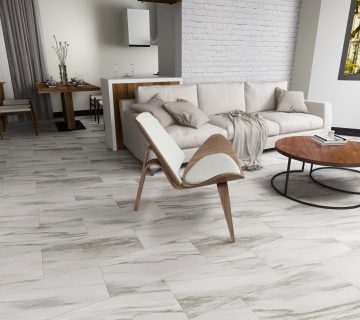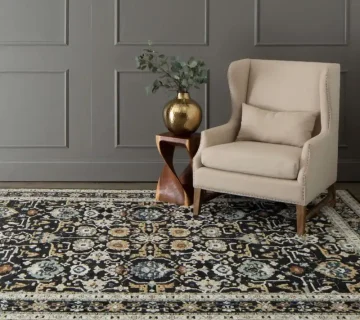This week we took on a small two day job. We spent the day laying vinyl flooring over vinyl flooring. Which can be tricky to get right but with the right information and procedures, any do-it-yourself-er and home owner can take on a job like this with confidence. As always I will list all tools and materials you will need to lay vinyl flooring over vinyl flooring.
Materials:
- Your new vinyl flooring
- Vinyl flooring adhesive (we used a releasable pressure sensitive adhesive from Chap-co)
- Skim coat
- Finish nails
- caulking(try and match the color of your flooring)
- Blue painters tape
- If not reusing old baseboard and thresholds your will need to purchase new
Tools:
- Razor blade (hook blade and standard blade)
- Hammer & flat bar
- Masonry Trowel
- Vacuum
- Finish nail gun(hammer and nail set will also work)
- Miter Saw(not necessary if reusing old moulding)
- Paint brush & roller(if using releasable pressure sensitive adhesive, with some adhesives you will need a 1/8 notched tile trowel to spread your glue, always make sure to read and follow the manufacturers instructions on container)
- Caulking gun
- 2×4 wrapped in carpet or a towel
Being a homeowner you will most likely own these tools. If not, you can pick them up at your local hardware store and not have to worry as you will be able to use any of these listed tools time and time again.
- Firstly and most obviously you will need to clear out the area. If its your kitchen it is always best to remove your refrigerator and stove to run the flooring under them.
- Using your hammer and flat bar, it’s time to remove any base board moulding or quarter round trim from around the edges of your floor. If you are going to simply reuse your old moulding make sure not to break any of your pieces as your removing them. Seeing as your going with a brand new floor I would suggest replacing all the moulding. It depends how beat up the old moulding is and your budget.
- Inspect your floor. Look for bubbles and loose areas. Using your razor blade, w/ a standard blade, cut out and remove these bad areas.
- Vacuum the floor of all dirt and debris to keep it out of your skim coat.
- Now it’s time to skim coat the floor. We used a Henry 547 Universal Patch & Skim Coat. This skim coat simply gets mixed with water. Follow the instructions on the package of whatever skim coat you choose to use. If you are filling in areas where it will be thicker you will want to fill those areas with a thicker mix. Using your masonry trowel, spread the skim coat across the entire floor. This will fill in the areas you needed to remove as well as any texture in the existing vinyl. Even if you don’t need to cut any areas out, your new vinyl will suck up tight to the old flooring so much that you will see the texture of the old floor come through to your new floor. This is a necessary step and is what makes laying vinyl flooring over vinyl flooring possible.
- Wrap it up, you’re done for about 14-18 hours depending on how long your skim coat product needs to set and dry.
- Now that your skim coat has dried. Inspect the surface. Using your trowel scrape off any drips or any lines you left. The key to the skim coat is to get it perfectly flat as possible.
- Vacuum the entire floor very thoroughly. Any debris you leave on your floor will be seen through the new vinyl.
- Now it is time to cut out your new vinyl flooring. There are a couple ways you might want to tackle this. You can simply take measurements and draw a diagram for yourself to follow. Another way is to get a roll of construction paper, lay it out and cut yourself a pattern. Either way you choose to do this you need to make sure to leave a good 2 inches all the way around. The hook blade works great for cutting out your new floor. If you are using a felt backed vinyl you will need to make relief cuts in the inside corners of your new flooring. You will also need to tape these corners with blue painters tape to reinforce them. Felt backed vinyl is brittle. It will crack and tear on you especially in those corners. If you are using a sheet vinyl product you will not have to worry about this.
- Carry your new flooring into the area and carefully spread it and lay it down where it goes. Using your standard blade push the excess you left into the corners and cut off the excess around the entire floor. If you are using a floor that has straight lines running through it you will want to make sure you have those lines lined up how you want them before you cut your floor. You may need to shift it over and if you have already cut it you might not be big enough to fit up to the wall.
- Once you have your floor all cut out and ready to go, it’s time for glue. with the releasable pressure sensitive adhesive you will be able to simply paint it on the floor. Other glues may require a notched trowel. Read and follow the directions on the glue you are using. The releasable adhesive is recommended, by the manufacturer, for sheet vinyl product. Fold back one side of your flooring about halfway back. Spread your glue. If you want a permanent bond with the releasable adhesive you won’t want to let it dry completely. Once the glue is ready, carefully lay your vinyl back where it was on the floor. Using a length of 2×4 covered in carpet(or wrapped in a towel) press and slide out the flooring towards the outside edges. This is going to force out bubbles and wrinkles, ensuring a tight bond. Repeat this for the other side of your floor.
- Now you can replace your old moulding and thresholds. If you choose to replace your moulding, make sure your measurements are correct and angles are correct. If you try using the old pieces as templates they will all run slightly larger and won’t fit in their places. If you weren’t able to get your floor perfect and there are some areas that aren’t completely covered, either by the base board or new flooring (i.e. around doorways and their trim), you can use caulking to fill in these areas.
- Some glues require waiting a while to dry, before moving any furniture or appliances on top of it. A good rule of thumb would be to wait a couple hours before moving things back, but just see what the product your using recommends and follow that.
It is a fairly simple process for any homeowner or do-it-yourself-er. The key is your skim coat. This is what makes laying vinyl flooring over vinyl flooring possible. The texture of your old floor WILL show through on your new vinyl if you do not skim coat it.
I mentioned felt back/paper back vinyl and whats called sheet vinyl. Vinyl itself is a very inexpensive material for a great looking brand new floor. The price range between your cheaper(felt backed, cracks and tears VERY easily) and your higher quality(sheet vinyl, won’t crack, tear or crease) vinyls isn’t a big difference. Sheet vinyl is so much easier to work with and lay. The difference in price will be well worth the frustration of installing it. Not to mention if you buy the cheaper vinyl and it tears, your going to need to either purchase a vinyl seam bonding product or go out and buy another piece of vinyl. We highly recommend using a sheet vinyl product with a releasable pressure sensitive adhesive for best results.



